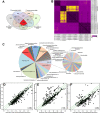Metabolomic similarities between bronchoalveolar lavage fluid and plasma in humans and mice
- PMID: 28698669
- PMCID: PMC5505974
- DOI: 10.1038/s41598-017-05374-1
Metabolomic similarities between bronchoalveolar lavage fluid and plasma in humans and mice
Abstract
This observational study catalogues the overlap in metabolites between matched bronchoalveolar lavage fluid (BALF) and plasma, identifies the degree of congruence between these metabolomes in human and mouse, and determines how molecules may change in response to cigarette smoke (CS) exposure. Matched BALF and plasma was collected from mice (ambient air or CS-exposed) and humans (current or former smokers), and analyzed using mass spectrometry. There were 1155 compounds in common in all 4 sample types; fatty acyls and glycerophospholipids strongly overlapped between groups. In humans and mice, more than half of the metabolites present in BALF were also present in plasma. Mouse BALF and human BALF had a strong positive correlation with 2040 metabolites in common, suggesting that mouse models can be used to interrogate human lung metabolome changes. While power was affected by small sample size in the mouse study, the BALF metabolome appeared to be more affected by CS than plasma. CS-exposed mice showed increased plasma and BALF glycerolipids and glycerophospholipids. This is the first report cataloguing the metabolites present across mouse and human, BALF and plasma. Findings are relevant to translational studies where mouse models are used to examine human disease, and where plasma may be interrogated in lieu of BALF or lung tissue.
Conflict of interest statement
The authors declare that they have no competing interests.
Figures




Similar articles
-
Oxidative stress in mouse plasma and lungs induced by cigarette smoke and lipopolysaccharide.Environ Res. 2008 Oct;108(2):199-204. doi: 10.1016/j.envres.2008.07.001. Epub 2008 Aug 21. Environ Res. 2008. PMID: 18721919
-
Metabolic profiling of potential lung cancer biomarkers using bronchoalveolar lavage fluid and the integrated direct infusion/ gas chromatography mass spectrometry platform.J Proteomics. 2016 Aug 11;145:197-206. doi: 10.1016/j.jprot.2016.05.030. Epub 2016 May 30. J Proteomics. 2016. PMID: 27255828
-
Effects of concurrent ozone exposure on the pathogenesis of cigarette smoke-induced emphysema in B6C3F1 mice.Inhal Toxicol. 2002 Dec;14(12):1187-213. doi: 10.1080/08958370290084818. Inhal Toxicol. 2002. PMID: 12454786
-
[A comparative study of two chronic obstructive pulmonary disease mouse models established by different methods].Zhonghua Jie He He Hu Xi Za Zhi. 2019 May 12;42(5):367-371. doi: 10.3760/cma.j.issn.1001-0939.2019.05.010. Zhonghua Jie He He Hu Xi Za Zhi. 2019. PMID: 31137113 Chinese.
-
Lilium lancifolium Thunb. extract attenuates pulmonary inflammation and air space enlargement in a cigarette smoke-exposed mouse model.J Ethnopharmacol. 2013 Aug 26;149(1):148-56. doi: 10.1016/j.jep.2013.06.014. Epub 2013 Jun 22. J Ethnopharmacol. 2013. PMID: 23796878
Cited by
-
Optimal LC-MS metabolomic profiling reveals emergent changes to monocyte metabolism in response to lipopolysaccharide.Front Immunol. 2023 Mar 23;14:1116760. doi: 10.3389/fimmu.2023.1116760. eCollection 2023. Front Immunol. 2023. PMID: 37033938 Free PMC article.
-
Pulmonary Toxicity and Inflammatory Response of E-Cigarette Vape Cartridges Containing Medium-Chain Triglycerides Oil and Vitamin E Acetate: Implications in the Pathogenesis of EVALI.Toxics. 2020 Jun 28;8(3):46. doi: 10.3390/toxics8030046. Toxics. 2020. PMID: 32605182 Free PMC article.
-
Omics and the Search for Blood Biomarkers in Chronic Obstructive Pulmonary Disease. Insights from COPDGene.Am J Respir Cell Mol Biol. 2019 Aug;61(2):143-149. doi: 10.1165/rcmb.2018-0245PS. Am J Respir Cell Mol Biol. 2019. PMID: 30874442 Free PMC article. Review.
-
Metabolomic analysis of fibrotic mice combined with public RNA-Seq human lung data reveal potential diagnostic biomarker candidates for lung fibrosis.FEBS Open Bio. 2020 Nov;10(11):2427-2436. doi: 10.1002/2211-5463.12982. Epub 2020 Oct 5. FEBS Open Bio. 2020. PMID: 32961634 Free PMC article.
-
Airway metabolic profiling during Streptococcus pneumoniae infection identifies branched chain amino acids as signatures of upper airway colonisation.PLoS Pathog. 2023 Sep 5;19(9):e1011630. doi: 10.1371/journal.ppat.1011630. eCollection 2023 Sep. PLoS Pathog. 2023. PMID: 37669280 Free PMC article.
References
Publication types
MeSH terms
Substances
Grants and funding
LinkOut - more resources
Full Text Sources
Other Literature Sources
Medical

